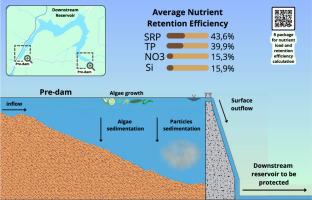前坝作为水库守护者的效率如何?关于养分滞留的长期研究
IF 11.4
1区 环境科学与生态学
Q1 ENGINEERING, ENVIRONMENTAL
引用次数: 0
摘要
评估养分负荷和处理对湖泊和水库的水质管理至关重要。量化和减少这些系统中的外部营养物质输入仍然是一项重大挑战。之所以困难重重,是因为对高度动态的外部输入进行监测的频率很低,而且减少扩散源负荷的措施也很有限。后者的一个选择是使用前置坝,即在水库入水口处设计小型蓄水池,通过藻类吸收和沉积作用保留营养物质。本研究分析了德国九个前置坝的长期(8 至 21 年)营养物和排水时间序列,以评估其滞留能力。为此,我们(i) 使用四种不同的数学方法量化了养分负荷,(ii) 得出了它们的滞留效率,(iii) 确定了决定氮(N)、磷(P)和硅(Si)滞留的环境因素。我们发现,可溶性活性磷(SRP)(43.6%)和总磷(TP)(39.9%)的滞留率远远高于硝酸盐(NO3)(15.3%)和硅(15.9%)。在温暖的季节,SRP 和 TP 的滞留效率较高,这是因为藻类营养吸收量较高,因此营养沉积量也较高。混合效应模型表明,前坝的水力停留时间(HRT)对截留效率有显著的正效应。前置坝在截留营养物质方面提供了大量服务,有助于保护下游水体免受营养物质输入的影响。它们是截留营养物质(包括来自非点源的营养物质)的有效措施。本文章由计算机程序翻译,如有差异,请以英文原文为准。


How efficient are pre-dams as reservoir guardians? A long-term study on nutrient retention
Assessing nutrient loading and processing is crucial for water quality management in lakes and reservoirs. Quantifying and reducing external nutrient inputs in these systems remains a significant challenge. The difficulty arises from low monitoring frequencies of the highly dynamic external inputs and the limited availability of measures to reduce diffuse source loading. One option for the latter is the use of pre-dams, i.e. small impoundments at the inflow points into reservoirs, designed to retain nutrients by algal uptake and sedimentation. This study analyzes long-term (ranging from 8 to 22 years) nutrient and discharge time series for nine German pre-dams to assess their retention capacity. For that, we (i) quantified nutrient loading using four different mathematical methods, (ii) derived their retention efficiencies, and (iii) identified environmental factors determining the retention of nitrogen (N), phosphorus (P), and silica (Si). We show that retention of soluble reactive phosphorus (SRP) (43.6 %) and total phosphorus (TP) (39.9 %) is far higher than for nitrate (NO3) (15.3 %) and Si (15.9 %). The retention efficiency for SRP and TP was higher during the warm seasons because of higher algal nutrient uptake and thus higher nutrient sedimentation. Mixed effects models documented a significant positive effect of the pre-dams’ hydraulic residence time (HRT) on retention efficiency. Pre-dams provide substantial service in retaining nutrients and help to protect downstream waterbodies from nutrient inputs. They provide effective measures for trapping nutrients including those originating from non-point sources.
求助全文
通过发布文献求助,成功后即可免费获取论文全文。
去求助
来源期刊

Water Research
环境科学-工程:环境
CiteScore
20.80
自引率
9.40%
发文量
1307
审稿时长
38 days
期刊介绍:
Water Research, along with its open access companion journal Water Research X, serves as a platform for publishing original research papers covering various aspects of the science and technology related to the anthropogenic water cycle, water quality, and its management worldwide. The audience targeted by the journal comprises biologists, chemical engineers, chemists, civil engineers, environmental engineers, limnologists, and microbiologists. The scope of the journal include:
•Treatment processes for water and wastewaters (municipal, agricultural, industrial, and on-site treatment), including resource recovery and residuals management;
•Urban hydrology including sewer systems, stormwater management, and green infrastructure;
•Drinking water treatment and distribution;
•Potable and non-potable water reuse;
•Sanitation, public health, and risk assessment;
•Anaerobic digestion, solid and hazardous waste management, including source characterization and the effects and control of leachates and gaseous emissions;
•Contaminants (chemical, microbial, anthropogenic particles such as nanoparticles or microplastics) and related water quality sensing, monitoring, fate, and assessment;
•Anthropogenic impacts on inland, tidal, coastal and urban waters, focusing on surface and ground waters, and point and non-point sources of pollution;
•Environmental restoration, linked to surface water, groundwater and groundwater remediation;
•Analysis of the interfaces between sediments and water, and between water and atmosphere, focusing specifically on anthropogenic impacts;
•Mathematical modelling, systems analysis, machine learning, and beneficial use of big data related to the anthropogenic water cycle;
•Socio-economic, policy, and regulations studies.
 求助内容:
求助内容: 应助结果提醒方式:
应助结果提醒方式:


